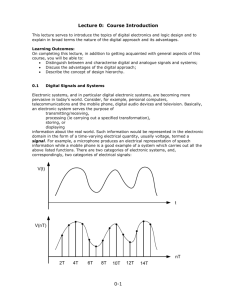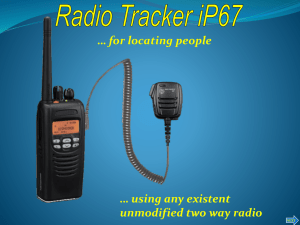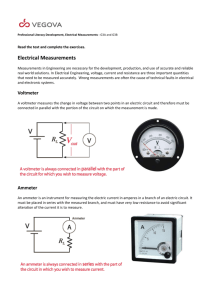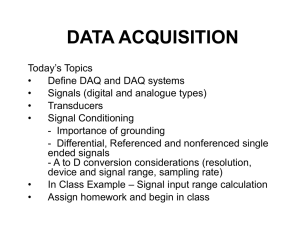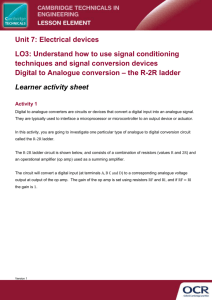Unit 1 Introduction to analogue
advertisement
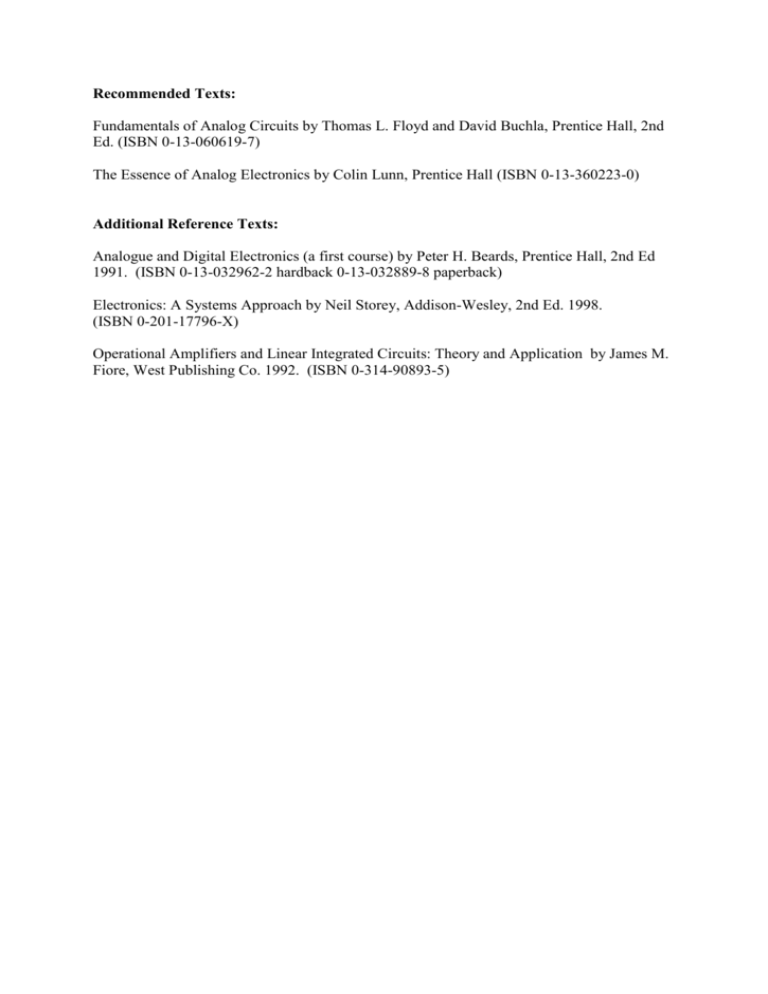
Recommended Texts: Fundamentals of Analog Circuits by Thomas L. Floyd and David Buchla, Prentice Hall, 2nd Ed. (ISBN 0-13-060619-7) The Essence of Analog Electronics by Colin Lunn, Prentice Hall (ISBN 0-13-360223-0) Additional Reference Texts: Analogue and Digital Electronics (a first course) by Peter H. Beards, Prentice Hall, 2nd Ed 1991. (ISBN 0-13-032962-2 hardback 0-13-032889-8 paperback) Electronics: A Systems Approach by Neil Storey, Addison-Wesley, 2nd Ed. 1998. (ISBN 0-201-17796-X) Operational Amplifiers and Linear Integrated Circuits: Theory and Application by James M. Fiore, West Publishing Co. 1992. (ISBN 0-314-90893-5) ELEK1289 - Electronic systems and practice II - Unit 1 – Introduction to Analogue 1 Introduction Electronic circuits are used in the manufacture of nearly all consumer products and electronic technicians are employed in industry to design, maintain, and troubleshoot a large variety of sophisticated electronic systems. Electronics covers a wide area of applications, such as the control of industrial processes, sound (audio) amplification, computers and the internet, telephone systems, radar systems, microwave systems, optoelectronic systems, motor and generator systems, television, radio, satellite and fibre optic data transmitters and receivers, to name but a few. The Electronic Systems modules take a systems approach, i.e. the circuit is viewed as a “black-box” and the behaviour of the system is studied. An introduction to some of the components and circuitry that make up electronic systems is covered in the Electric Circuits and Devices modules. 2 Analogue versus Digital Electronic systems can be divided into two broad categories, digital and analogue (Note that the American spelling is analog), however most electronic systems require both. Analogue systems operate with values that vary continuously and have no abrupt transitions between levels. Digital systems operate with discrete values. Analogue Waveform Digital Waveform 1 0 1 0 1 000 1 0 1 1 10 1 Since most physical quantities vary continuously (such as sound, position, velocity and temperature) analogue waveforms represent these quantities more realistically. However, the critical advantage of digital systems is that the data can be processed and transmitted more efficiently and reliably than with analogue systems. Also, digital signals can be stored and duplicated without degradation as, for example, on compact disc. Prior to digital technology, electronic transmission (such as broadcast and telephone) was limited to analogue technology. Digital technology is primarily used with new communications media, such as satellite and fibre optic transmission. In order to access the Internet, a modem is used to convert the digital information in your computer to analogue signals for your phone line and to convert analogue phone signals to digital information for your computer. Digital waveforms generally have two possible states, as shown in the diagram above. These states are most commonly represented by two voltage levels, a HIGH and a LOW. The states are also commonly referred to as 1 and 0 or ON and OFF or TRUE and FALSE. 2 ELEK1289 - Electronic systems and practice II - Unit 1 – Introduction to Analogue For a long time, almost all electronic systems were analogue, as most things we measure in nature are analogue. For example, your voice is analogue, it contains an infinite number of levels and frequencies. Therefore, if you wanted a circuit to amplify your voice, an analogue circuit seems a likely choice. However, demands in the telecommunications and the computer industry have led to a focus on digital electronics. For example, telephone exchange systems need circuits and devices that can make logical decisions based on certain input conditions. They need to be reliable circuits that operate the same way every time. Thus, today most analogue exchanges are now replaced by digital systems that provide greater capacity of data transfer and increased reliability and security. However, digital systems are not always the best option for a given application and in most electronic systems a combination of both analogue and digital circuits are required. 2.1 Example of an analogue electronic system A public address system Original sound waves Speaker Reproduced sound waves Linear amplifier Audio signal Amplified audio signal The original sound waves, which are analogue in nature are picked up by the microphone and converted to a small analogue voltage called an audio signal. This voltage varies continuously as the volume and frequency of the sound changes and is applied to the input of a linear amplifier. The output of the amplifier, which is an increased reproduction of the input voltage, goes to the speaker(s). The speaker changes the amplified audio signal back to sound waves that have a much greater volume than the original sound waves picked up by the microphone. 3 ELEK1289 - Electronic systems and practice II - Unit 1 – Introduction to Analogue 2.2 Example of a system with both analogue and digital circuits A CD player CD Drive Speaker 01001011010 Digital to analogue converter Digital Data Sound waves Linear amplifier Analogue reproduction of music audio signal Amplified audio signal The music is stored in digital form on the compact disk. A laser diode optical system picks up the digital data from the rotating disk and transfers it to a digital to analogue converter (DAC). The DAC changes the digital data into an analogue signal that is an electrical reproduction of the original music. This signal is amplified and sent to the speaker(s) or earphones for you to listen to. When the music was originally recorded on CD, a process essentially the reverse of the one described here, using an analogue-to-digital converter (ADC), was employed. 2.3 Summary of examples of analogue circuits ADDERS: AMPLIFIERS: These are used to add signals together Increase signals ATTENUATORS: Decrease signals CLIPPERS: COMPARATORS : CONVERTERS: DETECTORS: Prevent signals from exceeding some set amplitude limits Compares a signal against a reference, usually a voltage Changes a signal from one form to another, for example voltage-tofrequency converters Remove information from a signal, for example a radio detector removes voice or music from a radio signal DIVIDERS: Performs arithmetic division of a signal FILTERS: Removes unwanted frequencies from a signal MULTIPLIERS: Performs arithmetic multiplication of some signal characteristic, for example, amplitude multiplier OSCILLATORS: Change direct current to alternating current RECTIFIERS: Change alternating current to direct current REGULATORS: Hold some value, such a voltage or current, constant SWITCHES: Turn signals on and off or change the routing of signals through an electronic system. 4 ELEK1289 - Electronic systems and practice II - Unit 1 – Introduction to Analogue 3 Linearity Analogue systems perform certain operations. These operations are usually performed on signals where signals are electrical quantities, such as voltages or currents. For example, a microphone converts a human voice into a small voltage whose frequency and level change with time. The term Linear Electronics is usually used in the electronics industry when referring to analogue electronics. In a linear circuit the output is proportional to the input. For example, a resistor is a linear component in which an increase in current is proportional to the applied voltage as given by Ohm’s law. In general, a plot that shows the relationship between two variable properties of a device defines a characteristic curve. For most electronic devices, a characteristic curve refers to a plot of the current, I, plotted as a function of the voltage, V. For example, a resistor has an IV characteristic described by a straight line, as shown in below. I (mA) 10 R 1 9 8 7 6 5 4 3 2 1 V (V) 1 2 3 4 5 6 7 8 9 Example of IV characteristic curve for a resistor However, it should be noted that analogue electronic systems may also be non-linear systems. For example, the diode has a characteristic curve for which the current is not proportional to the voltage. I (mA) 10 9 8 7 6 5 4 3 2 1 V (V) 0.1 0.2 0.3 0.4 0.5 0.6 0.7 0.8 0.9 1.0 Example of IV characteristic curve for a diode 5 ELEK1289 - Electronic systems and practice II - Unit 1 – Introduction to Analogue 4 Periodic Signals A periodic signal repeats at a regular interval in time, for example, the sinusoidal waveform shown below. The period (T) represents the time for a periodic wave to complete one cycle. One cycle is the complete sequence of values that a waveform exhibits before another identical pattern occurs. The period can be measured between any two corresponding points on successive cycles. Periodic waveforms are used extensively in electronics. Many practical electronic circuits such as oscillators generate periodic waves. Most oscillators are designed to produce a particular shaped waveform, either a sinusoidal waveform or non-sinusoidal waves such as square, rectangular, triangle and sawtooth waves. The most basic and important periodic waveform is the sinusoidal wave. Both the trigonmetric sine and cosine functions have the shape of a sinusoidal wave. The term sine wave implies the sine function, whereas the term sinusoidal wave means a waveform with the shape of a sine wave. A sinusoidal waveform is generated as the natural waveform from many ac generators and in radio waves. Sinusoidal waveforms are also present in physical phenomena from generation of laser light, the vibration of a tuning fork, or the motion of ocean waves. y(t) = A sin ( t ) y(t) Period, T Amplitude, A t Sinusoidal Waveform is a periodic signal A sinusoidal curve may be expressed mathematically as: y(t) = A sin (t ) y(t) vertical displacement of curve from horizontal axis as a function of time A amplitude is the maximum displacement from the horizontal axis angular frequency in radians per second t time in seconds to a point on the curve phase angle in radians is simply a fraction of a cycle that a waveform is shifted from a reference waveform of the same frequency. It is positive if the waveform begins before t=0 and is negative if the curve starts after t=0. 6 ELEK1289 - Electronic systems and practice II - Unit 1 – Introduction to Analogue y(t) Period, T Amplitude, A t y(t) Period, T Amplitude, A t Examples of Non-sinusoidal Periodic Waveforms 5 Frequency Frequency is the number of cycle per second, where one complete cycle is 2 radians. Thus dividing the angular frequency () by the number of radians in one cycle (2) gives the frequency in hertz. f 2 where: f frequency in hertz (i.e. number of cycles per second) angular frequency in radians per second number of radians per cycle 2 The time in seconds for one cycle is the period, T. Thus the frequency in hertz is the reciprocal of the period. 1 f T For example, if a signal repeats every 1 ms, then its period is 1 ms and its frequency is 1 1 f 1 10 3 1kHz 3 T 1 10 7 ELEK1289 - Electronic systems and practice II - Unit 1 – Introduction to Analogue 6 Amplitude of Sinusoidal Wave The amplitude of a sinusoidal wave is the maximum displacement from the horizontal axis. For a voltage signal, the amplitude is called the peak voltage (Vp). When making voltage measurements with an oscilloscope, it is easier to measure the peak-to-peak voltage (Vpp). The peak-to-peak voltage is twice the peak value. V(t) = Vpsin ( t ) Voltage, V(t) +Vp Peak Voltage, Vp Peak-to-Peak Voltage, Vpp t -Vp 6.1 Peak Voltage (Vp) Average Value of Sinusoidal Wave During one complete cycle, a sinusoidal waveform has equal positive and negative excursions. Therefore, the mathematical definition of the average value of a sinusoidal waveform must be zero. However, the term average value is generally used to mean the average over a cycle without regard to sign. That is, the average is computed by converting all negative values to positive and then averaging. Thus Vavg 2VP 0.637VP 6.2 Effective Value (rms Value) of Sinusoidal Wave In order to compare ac and dc voltages and currents, ac voltages and currents are defined in terms of equivalent heating value of dc. This equivalent heating value is computed with calculus and the result is called the rms (root-mean-square) voltage or current. The rms voltage is related to the peak voltage by the following equation. Vrms 0.707VP 8 ELEK1289 - Electronic systems and practice II - Unit 1 – Introduction to Analogue 7 Exercises 7.1 Exercise 1 An oscilloscope shows a wave repeating every 27 s. What is the frequency of the wave? 7.2 Exercise 2 A Digital Multi-Meter (DMM) indicates the rms value of a sinusoidal wave. If the DMM indicates a sinusoidal wave is 3.5 V, what peak-to-peak voltage would you expect to observe on an oscilloscope? 7.3 Exercise 3 A voltage waveform is described by the following equation: V(t) = 20 sin(500 t) (i) (ii) (iii) (iv) Determine the peak voltage and the average voltage. Find the instantaneous voltage at time = 10 ms Determine the rms voltage. Find the frequency in hertz and the period of the waveform 7.4 Exercise 4 A voltage waveform is described by the following equation: V(t) = 100 sin(200t + 0.52) (i) (ii) (iii) (iv) Determine the peak voltage and the average voltage. Find the instantaneous voltage at time = 2 ms Determine the rms voltage. Find the frequency in hertz and the period of the waveform 9 ELEK1289 - Electronic systems and practice II - Unit 1 – Introduction to Analogue 8 Analogue System – Black Box Approach When analysing a complex electronic system, it is usual to break it down into a number of functional blocks. It is usual to model an analogue system using block diagrams. A block diagram shows all the individual functions of a system and how the signals flow through the systems. This is used for system level test and debug. A schematic diagram shows all the individual parts of the circuit and how they are interconnected. This is required for component-level troubleshooting. Troubleshooting begins at system level, where the technician observes symptoms and makes measurements to determine which function or functions are faulty. This may lead to an entire module, panel or circuit board being replaced. Component level debug usually takes longer than system-level debug, so it may be more economical to replace an entire module or circuit board. Open Loop System Input Signal Input Electronic Function Output Signal Output Power Supply Open Loop System Closed Loop System FEEDBACK information feed back from output to input Input Signal Input Electronic Function Output Signal Power Supply Closed Loop System 10 Output


